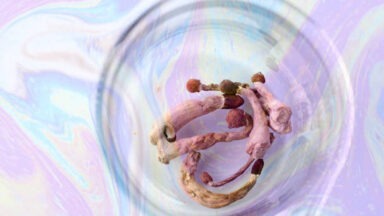These Ancient Civilizations Knew About Our Third Eye

The Seat of the Soul
The significance of the pineal gland has been the subject of investigation for centuries, with its first documentation tracing back to a Greek doctor and philosopher known as Galen. Galen’s colleagues believed the pineal regulated the flow of ‘psychic pneuma,’ or an ethereal substance referred to as ‘the first instrument of the soul.’ But Galen refuted this, instead, thinking the pineal was simply a gland that regulated blood flow.
A resurgence of supernatural characteristics associated with the pineal returned when René Descartes took interest in it. He asserted it was ‘the principal seat of the soul,’ and believed it to be the source of all thought. Descartes was essentially credited with reflex theory or the involuntary system of actions carried out in the body’s function.

René Descartes
He thought of this in the sense that the mind could be separated from the body, with the ability to take over the animal instincts, making its entrance through the pineal gland. Descartes believed the pineal was unique because it did not have a matching pair, like most other sensory organs.
“It must necessarily be the case that the impressions which enter by the two eyes or by the two ears, and so on, unite with each other in some part of the body before being considered by the soul. Now it is impossible to find any such place in the whole head except this gland; moreover, it is situated in the most suitable possible place for this purpose, in the middle of all the concavities.” – Réne Descartes
Hinduism’s Third Eye
Shiva and other Hindu deities are often depicted with a literal third eye on their forehead. This eye represents an awakening, or enlightenment, as the ability to see into higher realms of existence and consciousness. Many interpret this third eye as the pineal gland.
Shiva’s dreaded hair wrapped in snakes looks strikingly similar to a pinecone, the namesake of the gland itself. Snakes in Hinduism are thought to be auspicious, most notably seen in imagery surrounding Kundalini Yoga. The body’s chakras are often depicted in Kundalini by a winged staff encircled by two snakes, or a Caduceus as it is known in Greek mythology. The snakes meet at the Ajna chakra, where the pineal and pituitary glands are located. This chakra is known as the source of consciousness, with Ajna translating to command or guidance.

Ancient Egypt’s Eye of Horus/Eye of Ra
Many are familiar with the Eye of Ra and the Eye of Horus from ancient Egyptian iconography. Aside from the eye’s striking resemblance to a lateral view of the pineal gland within the brain, these depictions in Egyptian hieroglyphs are always singular. In addition to its lack of a counterpart, it was often drawn on the center of the foreheads on sarcophagi. Another reference to the location of the pineal, mirroring Hindu mythology is that of a snake emerging from the center of the forehead, also seen on pharaohs’ sarcophagi. Egyptians regarded the snake auspiciously as well, associating it with wisdom.

Pinecone Imagery
Many portrayals of Sumerian gods depict a pinecone extended in one hand. These gods are believed to be a representation of the Anunnaki, or an ancient extraterrestrial visitor race and their ability to access the pineal for its consciousness-expanding abilities. Pinecones can be found in ancient Greek mythology on the staff of Dionysus, or his Roman iteration Bacchus.

A pinecone staff with snakes wrapped around it is also carried by Osiris in Egyptian lore. Cambodian temples in Angkor Wat bear a striking resemblance to pinecones and there is even a massive pinecone statue at the Vatican, originally situated next to a temple for the Egyptian god Isis, in ancient Rome.
These ancient ancestors clearly had a healthy awareness of our pineal gland and the mysticism surrounding its connection to a higher level of consciousness. Its pinecone shape adds to the mysterious symbolism seen across cultures. It comes as no surprise that the pinecone also forms in a sacred geometric pattern from Fibonacci’s golden ratio.
What did our ancestors know about the pineal gland that we don’t?
Isochronic Tones: The Young Cousin of Binaural Beats

“If you look at the anatomy, the structure, the function, there’s nothing in the universe that’s more beautiful, that’s more complex, than the human brain.”
– Keith Black (Discover magazine, April, 2004)
The brain is experiencing quite the renaissance as of late. Not only has brain research become more easily accessible and immediately applicable, the implications of the latest research are pointing to a wonderful outcome: we now know that specific locations in the brain can be pinpointed, accessed, addressed, flooded with light to heal symptoms, and healed through the emission of sound.
What’s even more compelling is that several categories of brain research are inspiring the creation of accessible and wearable technologies that can help soothe and heal the brain, along with other parts of the body.
The brain is no longer an anomaly. It’s now scientifically proven that when the brain is nurtured by light, sound and frequencies, it passes that healing along to the whole system.
It’s All About Light & Sound
“If you want to find the secrets of the universe, think in terms of energy, frequency, and vibration.”
-Nikola Tesla
Sound therapy has come a long way since its new-age hippie roots. Sound Therapy is now utilized by a variety of global organizations and businesses. This includes business offices, hotel chains, medical facilities, universities, and a variety of treatment programs, as an effective treatment to alleviate pain and depression, lower blood pressure, overcome feelings of stress, improve learning, improve balance, and promote physical and mental endurance.
According to the Mayo Clinic, light therapy treats seasonal depression and other conditions by exposure a person to artificial light. During light therapy, the individual sits or works near a device called a light therapy box, which come in a variety of forms, shapes, and sizes.




































